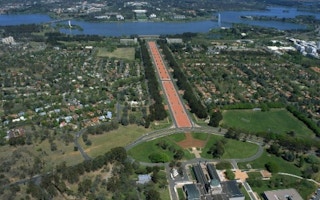Adapting to the unavoidable impacts of climate change is a major emerging environmental sustainability issue for Canberra.
Since the middle of the 20th century, Australian temperatures have, on average, risen by about 1°C with an increase in the frequency of heatwaves and a decrease in the numbers of frosts and cold days. Rainfall patterns have also changed—the north-west has seen an increase in rainfall over the last 50 years while much of eastern Australia and the far south-west have experienced a decline.
Canberra in Australia has a significant social and cultural affinity with their natural environment; it not only defines their image of their city – the Bush Capital – but allows them to readily enjoy the beauty and diversity of their environment.
The Green Building Council of Australia chief executive, Romilly Madew, says Canberra has the largest number of green-star certified buildings in Australia.
Ms Madew adds that more medium and high density housing is needed to prevent urban sprawl spoiling the bush capital.
She believes the capital does not need more land for housing, noting that greater London covers the same area as Canberra but is home to 7 million people. “There are more opportunities in Canberra to go up - and when I say that I don’t mean 10 storeys, 15 storeys - it could be three or four storeys,” she said.
However, issues regarding public transport, water and energy also need to be addressed, along with the question of how to attract and manage a sustainable population.
At the close of last winter Canberra had experienced 17 consecutive winters with above average maximum temperatures. 2009 was the third warmest winter on record.
The plan for Canberra needs to incorporate measurable sustainability targets.
The immediate challenge for all Canberrans is to reduce their greenhouse gas emissions. In 2006, ACT net greenhouse gas emissions totaled 4.02 Mt CO2-e. This equates to an increase of 25.2 % on 1990 levels and is 10.4 % above 2000 levels.
Canberra has a good environmental history when it comes to the consumption of water and treatment of waste water. Their suburban storm water system continues to reflect best environmental engineering practice and over the last six years their water consumption per household has decreased.
In Balance with Natural Resources
Retaining and enhancing their natural resources will require the residents of Canberra to consider how they live alongside, and interact with, the environment. They will therefore have to consider how they can use land more efficiently and incorporate environmental engineering and design into the design of their homes and public places to enhance their biodiversity.
Research by the ACT Government shows that Canberra’s overall air quality is excellent, primarily due to their lack of heavy industry. However, it does experience elevated particle pollution during winter due to emissions from domestic wood heaters.
The Canberra community is similarly concerned about environmental sustainability. The Australian Capital Territory recorded some of the highest proportions of adults who felt the condition of the natural environment was bad (33 %) or declining (64 %) with 81 % concerned about climate change.
Steps towards a sustainable Canberra
Air quality
The ACT Government aims to reduce winter air pollution by:
- launching in 2001 the Don’t Burn Tonight campaign. This program encourages Canberrans to act responsively by using alternative heating on cold, still nights when smoke is unlikely to clear quickly
- implementing the Wood Heater Replacement Program by offering a financial incentive for replacing old wood heaters with new mains supplied natural gas heaters.
Waste
Waste management is an integral part of a sustainable Canberra and is an issue that affects every individual and organisation in the ACT. Sustainable waste management reduces pressure on raw materials, reduces greenhouse gas emissions and creates a clean Canberra. The ACT Government is developing a future waste strategy to replace the existing No Waste by 2010.
Vicky Kenrick is an Advertising and Marketing Communications specialist for international sustainability recruitment consultancy, Allen & York.










